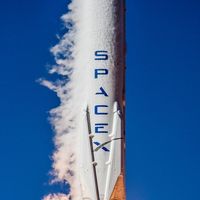Space Ventures and Spectrum Shifts: The New Frontier of U.S. Space Policy
May 3, 2025, 10:34 am

Location: United States, District of Columbia, Washington
Employees: 1001-5000
Founded date: 1934
Total raised: $1.43B

Location: United States, District of Columbia, Washington
Employees: 5001-10000
Founded date: 2002
Total raised: $7.53B
The U.S. space landscape is changing. The Senate Commerce Committee has taken a significant step by advancing President Trump's nominees for NASA and the Federal Communications Commission (FCC). This move signals a new era for American space exploration and telecommunications.
At the helm of NASA, Jared Isaacman stands poised to lead. He’s not just any nominee; he’s a seasoned entrepreneur and a space traveler. As CEO of Shift4 Payments, he’s familiar with high-stakes environments. If confirmed, he will oversee a workforce of 18,000 and manage a budget of about $25 billion. His mission? To return astronauts to the moon under the Artemis program. This initiative, launched during Trump’s first term, aims to establish a sustainable human presence on the lunar surface.
But the moon is just a stepping stone. Trump and his allies, including Elon Musk, have their eyes set on Mars. The vision is grand, but it raises questions about the moon program. Billions have been allocated for lunar exploration, yet the allure of Mars is undeniable. It’s a cosmic tug-of-war, with resources stretched thin between two celestial bodies.
SpaceX plays a crucial role in this narrative. With contracts worth approximately $15 billion, it’s the backbone of NASA’s astronaut transport. SpaceX’s vehicles are the only U.S. option for sending astronauts to space. The company is also developing a lunar lander, set to carry crews to the moon later this decade. The partnership between NASA and SpaceX is a marriage of necessity and ambition.
Meanwhile, the FCC is shifting gears. The agency has voted to review its spectrum sharing rules, a move that could reshape space-based telecommunications. The current regulations, established in the 1990s, impose power limits that stifle innovation. These restrictions hinder satellite broadband, degrading signal quality and limiting coverage. FCC Chair Brendan Carr argues that these outdated rules are holding back progress.
The review aims to unlock the potential of satellite systems like SpaceX’s Starlink. With the demand for high-speed internet skyrocketing, the need for robust satellite communication is critical. SpaceX’s Starlink promises to deliver broadband to underserved areas, bridging the digital divide. But to do so, it needs more spectrum. The FCC’s willingness to revisit these rules is a beacon of hope for the industry.
The intersection of space exploration and telecommunications is a fertile ground for innovation. As NASA pushes forward with its lunar ambitions, the FCC’s actions could enhance the capabilities of satellite systems. This synergy could lead to a new era of connectivity, not just on Earth but beyond.
The stakes are high. The U.S. is in a race not just with other nations but with itself. The vision of a human presence on Mars is tantalizing, yet the path is fraught with challenges. Funding, technology, and international cooperation will be crucial. The moon program must not falter in the shadow of Martian dreams.
As Isaacman prepares to take the reins at NASA, his experience as a private astronaut could offer a fresh perspective. He understands the thrill of space travel and the complexities of commercial partnerships. His leadership could bridge the gap between government objectives and private sector innovation.
The FCC’s review of spectrum sharing is equally pivotal. It’s a chance to revitalize the satellite industry. By loosening restrictions, the FCC could foster competition and innovation. This could lead to better services for consumers and a stronger position for the U.S. in the global telecommunications arena.
The collaboration between NASA and SpaceX exemplifies the power of public-private partnerships. It’s a model that could be replicated across various sectors. As the U.S. navigates its space ambitions, leveraging the strengths of both government and private entities will be essential.
In conclusion, the U.S. is at a crossroads in its space policy. The Senate’s advancement of key nominees signals a commitment to bold exploration. The FCC’s review of spectrum sharing rules could unleash a wave of innovation in satellite communications. Together, these developments could redefine America’s role in the cosmos. The moon and Mars await, but the journey begins with the right leadership and a willingness to adapt. The stars are not just a destination; they are a promise of what’s possible.
At the helm of NASA, Jared Isaacman stands poised to lead. He’s not just any nominee; he’s a seasoned entrepreneur and a space traveler. As CEO of Shift4 Payments, he’s familiar with high-stakes environments. If confirmed, he will oversee a workforce of 18,000 and manage a budget of about $25 billion. His mission? To return astronauts to the moon under the Artemis program. This initiative, launched during Trump’s first term, aims to establish a sustainable human presence on the lunar surface.
But the moon is just a stepping stone. Trump and his allies, including Elon Musk, have their eyes set on Mars. The vision is grand, but it raises questions about the moon program. Billions have been allocated for lunar exploration, yet the allure of Mars is undeniable. It’s a cosmic tug-of-war, with resources stretched thin between two celestial bodies.
SpaceX plays a crucial role in this narrative. With contracts worth approximately $15 billion, it’s the backbone of NASA’s astronaut transport. SpaceX’s vehicles are the only U.S. option for sending astronauts to space. The company is also developing a lunar lander, set to carry crews to the moon later this decade. The partnership between NASA and SpaceX is a marriage of necessity and ambition.
Meanwhile, the FCC is shifting gears. The agency has voted to review its spectrum sharing rules, a move that could reshape space-based telecommunications. The current regulations, established in the 1990s, impose power limits that stifle innovation. These restrictions hinder satellite broadband, degrading signal quality and limiting coverage. FCC Chair Brendan Carr argues that these outdated rules are holding back progress.
The review aims to unlock the potential of satellite systems like SpaceX’s Starlink. With the demand for high-speed internet skyrocketing, the need for robust satellite communication is critical. SpaceX’s Starlink promises to deliver broadband to underserved areas, bridging the digital divide. But to do so, it needs more spectrum. The FCC’s willingness to revisit these rules is a beacon of hope for the industry.
The intersection of space exploration and telecommunications is a fertile ground for innovation. As NASA pushes forward with its lunar ambitions, the FCC’s actions could enhance the capabilities of satellite systems. This synergy could lead to a new era of connectivity, not just on Earth but beyond.
The stakes are high. The U.S. is in a race not just with other nations but with itself. The vision of a human presence on Mars is tantalizing, yet the path is fraught with challenges. Funding, technology, and international cooperation will be crucial. The moon program must not falter in the shadow of Martian dreams.
As Isaacman prepares to take the reins at NASA, his experience as a private astronaut could offer a fresh perspective. He understands the thrill of space travel and the complexities of commercial partnerships. His leadership could bridge the gap between government objectives and private sector innovation.
The FCC’s review of spectrum sharing is equally pivotal. It’s a chance to revitalize the satellite industry. By loosening restrictions, the FCC could foster competition and innovation. This could lead to better services for consumers and a stronger position for the U.S. in the global telecommunications arena.
The collaboration between NASA and SpaceX exemplifies the power of public-private partnerships. It’s a model that could be replicated across various sectors. As the U.S. navigates its space ambitions, leveraging the strengths of both government and private entities will be essential.
In conclusion, the U.S. is at a crossroads in its space policy. The Senate’s advancement of key nominees signals a commitment to bold exploration. The FCC’s review of spectrum sharing rules could unleash a wave of innovation in satellite communications. Together, these developments could redefine America’s role in the cosmos. The moon and Mars await, but the journey begins with the right leadership and a willingness to adapt. The stars are not just a destination; they are a promise of what’s possible.